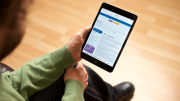Social care has historically not been the most technologically advanced sector. When the desktop computer became common in many industries, the mobile nature of care meant that frontline carers had no opportunity to take advantage of computer systems. However, modern mobile devices, such as the iPhone, have allowed social care to adopt fully digital processes, including care planning and evidencing of care software.
The coronavirus outbreak demonstrated that sharing information is crucial to help improve clinical decision-making, as the lack of knowledge of the impact in care homes before led to some poor choices at the time. The NHS and DHSC have realised that they need more information about the care provided in social care and that social care itself would benefit from having access to healthcare information. Although the ideal is for both parties to have access to a standard set of information that meets the needs of all parties, two challenges need to be addressed. The first is that more than 50% of care providers in the UK are still operating paper-based care systems, which means there is no opportunity for digital interoperability. The second is the plethora of systems in use across health and social care.
Two initial solutions were selected; one was the Summary Care Record Application, whereby 11,000 iPads were distributed to care providers to access the healthcare records of the people they provided care for. The other was Capacity Tracker, which asked care providers to supply a summary of information about the people in their care. These two solutions had the opportunity to provide the necessary information to both parties. Still, the problem is that care providers generally don’t operate how these solutions operate. In addition, many social care providers have adopted digital care systems that operate in line with their care practices, so having an alternative system that is not in line with their care processes adds a burden.
Moreover, it soon became apparent that social care needed to continue to use systems suited to their care practices; communicating this information to other parties, including the regulator, could help to ensure the best decisions are made. A pilot study that collected specific COVID statistics from several care providers showcased that social care could collate information across different systems based on a common standard.
That said, one obstacle with data sharing is that, until now, healthcare information was unavailable outside of healthcare professionals. This meant that a registered nurse working in a nursing home could access information, but the manager they reported to couldn’t. It also meant that there was no access to residential care homes or domiciliary care providers. Fortunately, in the past few weeks, this situation has been resolved. All types of registered social care providers in England can now view healthcare information digitally, in many cases from within their day-to-day care software. However, social care providers still need to demonstrate they have the digital maturity to manage medical information about an individual in their care by meeting the standards set by the Data Security and Protection Toolkit. Only then will they be given access to the vast array of healthcare information required to deliver outstanding care.
The standards for communicating information from social care to healthcare are still being developed. Still, many paper-based care providers are not able to share their information digitally without the onerous option of dual entry. The initiative of providing financial support to social care to adopt digital systems, which has led to the Assured Supplier List, aims to increase the percentage of digitally enabled care providers to 80% by 2024 – using systems capable of meeting the standards set for interoperability.
Two years ago, the vision of social care providers having systems that interoperate with healthcare seemed decades away. The pandemic has shown that the two sectors can work together to create standards that enable interoperability, and the obstacles, once clearly expressed, can be overcome.
Overall, the past 24 months have shown that social care has started to lead the way in the use of technology, particularly in the use of software designed to share information. The concept of a Shared Care Record being utilised across all systems, with the current version of any person’s medical and care information available to all who need it, is tantalisingly close to becoming a reality.
By Jonathan Papworth
Jonathan Papworth is the founder of Person Centred Software, a digital care technology pioneer. Founded in 2013 to improve the quality of life for people in social care, Person Centred Software has become an award-winning global company with over 3,000 care providers in the UK alone using their digital care management system.





